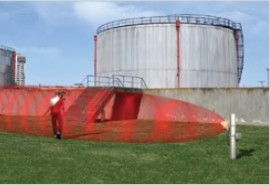INTREPID™ MicroWave 316
Digital microwave link
INTREPID™ MicroWave 316 is a volumetric perimeter detection system for fencelines, open areas, gates, entryways, walls and rooftop applications. Based on Southwest Microwave’s field-proven microwave detection technology, advanced Digital Signal Processing (DSP) discriminates between intrusion attempts and environmental disturbances, mitigating risk of site compromise while preventing nuisance alarms. The system’s polling capabilities enable continuous monitoring of alarm and tamper status.

Description
MicroWave 316 operates at K-band frequency, achieving superior performance to X-band sensors. Because K-band is 2.5 times higher than X-band, the multipath signal generated by an intruder is more focused, and detection of stealthy intruders is correspondingly better. K-band frequency also limits susceptibility to outside interference from air/seaport radar or other microwave systems.
Antenna beam width is approximately 3.5 degrees in the horizontal and vertical planes. A true parabolic antenna assures long range operation, superior beam control and predictable Fresnel zones. Advanced receiver design increases detection probability by alarming on partial or complete beam interruption, increase / decrease in signal level or jamming by other transmitters.
MicroWave 316’s Tethered mode of operation optimizes sensor control. Its on-board synchronization circuitry eliminates external interference and allows multiple MicroWave 316’s and Southwest Microwave transceivers to operate without mutual interference. An alternate Free Running mode features modulation channels with narrow band filtering, preventing interference between sensors. Units can be stacked in either mode for ultra-high security applications.
As part of the new-generation INTREPID™ family, MicroWave 316 networks seamlessly with the MicroPoint™ II and MicroNet™ II Fence Detection Systems and MicroTrack™ II Buried Cable Detection System using a common, open architecture communications protocol.
Key features
- Range: 122 m
- Single platform networking
- Digital signal processing for high PD / low NAR
- Fresnel suppression algorithms reduce outer field disturbances
- Software-controlled setup
- Built-in synchronization prevents interference between sensors
- Tethered mode for optimal sensor control and interference resistance






